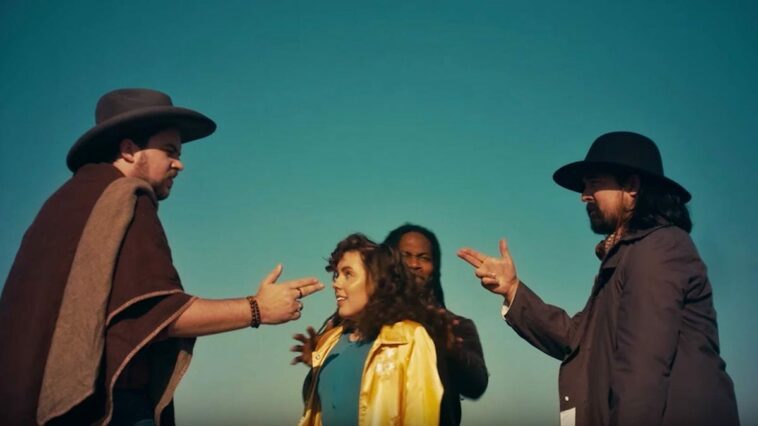
For those not in the know, Man Man is a band that used to be described by what I like to refer to as Anarcho Avant-Garde. As far as I know, I just made that up, but their early work is positively wild, with nonsensical titles like “Spider Cider,” “White Rice, Brown Heart,” “Tunneling Through the Guy,” “The Ballad of Butter Beans,” and even one called “Fish Stick Gumbo,” which is a four-second track of someone laughing maniacally before closing a door. The lead singer, Honus Honus, is something of an underground icon. He combines generally great vocals with absolutely wild music and lyrics, and the band’s numerous other members chime in with instruments that are rarely seen and extremely unorthodox.
Their songs touch on everything from dating someone whose parents abuse them to being with someone who indulges in every fetish their perverse minds can come up with. It’s why I think anarchic is the best descriptor of their earlier work. You never know what to expect next and it does not follow the rules.
Fast forward to 2013, where they dropped On Oni Pond, an album that holds much more mainstream appeal than their prior works. Gone was the overwhelming percussion and insane singing, and in its place was something much, much poppier. From what I know, it is their bestselling album. Or maybe that’s just the case in the small amount of people. Someone I used to know described the album as follows: “My sister owns a copy of On Oni Pond.” I think his point was that it’s not a bad album by any stretch of the imagination, but that it wasn’t what fans necessarily wanted from the band. It employed many more electronic elements, with several songs featuring rather heavy use of synth and following fairly standard pop patterns. I like the album a lot, but my favorite by them is Six Demon Bag, their second album and one that is borderline a horror movie soundtrack at times.
Let’s now fast forward again to…well, now. Man Man surprised their small but dedicated following by announcing and releasing Dream Hunting in the Valley of the In-Between, an album that mostly ditches the more artificial elements of On Oni Pond by employing more percussion and brass, like in their early days, while also retaining its mainstream appeal thanks to several songs that, to paraphrase Stephen King, “Have a great beat and you can dance to them.” The album veers between the darker emotional stuff from their past, while also being nonsensical at times.
We open with “Dreamers,” a lovely little song that calls to mind smoke-filled bars and tough guys, classic noir stuff, with its mixture of piano and sax, before launching straight into “Cloud Nein,” the first single from the album that the band dropped. It’s simple, catchy, and uses upbeat tunes to convey a message about people essentially denying their own mortality. I mean, just watch the music video. It’s an old guy dancing happily on empty streets before the world explodes.
What does it all mean? Is it a criticism of climate change deniers? Is it more a commentary on the current situation the world is in? Your guess is as good as mine, or maybe better because I’m not particularly great at understanding music.
“On the Mend” treads over familiar ground of someone speaking to another about how the solution to their life’s problems aren’t in the person they’ve built up in their mind as some kind of savior. It’s more subdued, but not less infectious than the previous tracks. Meanwhile, “Lonely Beuys” is the second part of that story, directly addressing the person’s denial of the bad parts of their life. It is far catchier than it should be given the sad subject matter, but that’s just Man Man. And even more oddly, both of these songs feature YouTuber Rebecca Black, as well, and she isn’t bad in them.
“Future Peg” is the second Big Bop of the album, with largely nonsensical lyrics about people having mental breakdowns. It’s followed immediately by “Goat,” the song that feels the most like Man Man’s early work. It employs a constant, hypnotic beat and an odd, dissonant sax to deliver a song that largely compares an unknown woman to various pieces of food, before moving on to a doctor that’s likely cheating on his wife. To me, it’s one of the standout tracks on the album, as it is catchy while also being oddly uncomfortable and off-putting. It’s memorable and strange, which are two things I value a lot.
“Inner Iggy” follows, and it feels perfect for the early summer, conjuring up images of the beach by combining surf rock with Salsa, and it’s perhaps the best “short but sweet” track on the album. “Hunters,” meanwhile, feels like a show tune as only Honus Honus could produce, leaning heavily on piano and xylophone but dealing with someone not being able to emotionally fulfill their lover. This is then followed immediately by “Oyster Point,” which heavily echoes their early song “Young Einstein on the Beach,” although far less chaotic. It’s 30 seconds of strange noises, essentially.
“The Prettiest Song in the World” deals with Satan 69ing with men in a motel room in Kansas, and shopping til you drop, but ends with a very direct message to the listener, saying that he wanted to write the prettiest song in the world but got distracted. It is also classic Man Man, with a fantastic instrumental section in the middle before being punctuated by something both sad and funny.
Meanwhile, “Animal Attraction” feels like a callback to “Gold Teeth” from Man in a Blue Turban with a Face in that it is an intimate song about the failing relationship between two people, and the singer just can’t seem to break it off. Of all the songs on the album, this one feels the most personal, and I just hope that someday Honus Honus can work out his relationship problems. “Sheela” and “Unsweet Meat” follow that up with two faster paced songs, with the former feeling as close to straightforward rock as the band has ever been and the latter being a nice, strange pallet cleanser before the final stretch.
The final few songs, weirdly enough, almost feel like they work best when listened to together all at once. “Swan” is a brief, bittersweet piano-based song that almost feels like it could be the end of the group’s career. It has the strange, unorthodox lyrics they’re known for while also carrying with it an indescribable feeling of melancholy. He says, “it’s only a little bit of alchemy/and the blood of a dying swan,” before moving on to “Powder My Wig,” about being drawn to someone with the same amount of self-destructive tendencies as the singer does. It’s rather low-key, but a catchy little beat that sets up some of the earlier tracks.
“If Only” is the penultimate track on the album, with a lovely duet between Honus Honus and Dre Babinski. It’s a wonderful, downbeat song about two people who shouldn’t be together trying to reconcile the sins they’ve committed against one another (there’s that topic popping up again). The final track is “In the Valley of the In-Between,” a short, melancholy piano piece that echoes the feelings of “Dreamers”; it feels nostalgic and lustful, but it lacks that sense of hope present in the first track. It ends the album not with a bang, but a sad sob, and lets the listener reflect on everything that’s come before it on the album.
Dream Hunting in the Valley of the In-Between does just that for longtime fans of Man Man. It combines the instrumental and sometimes chaotic elements of their earlier work with the more straightforward, new-listener-friendly parts of On Oni Pond. I don’t know if it is the last-ever Man Man album the world will see, but in many ways, it feels like a reconciliation of all that’s come before, both with the band, and, I’m assuming, with the problems that Honus Honus, AKA Ryan Kattner, has dealt with throughout his life.
To me, it should appeal to fans both old and new, with its reliance on practical instruments and the catchy beats it uses to explore some very dark subject matter. It is a lovely return from the hiatus the musical group has been on, and despite the finality in its themes, hopefully a sign of more to come from one of music’s strangest bands.

